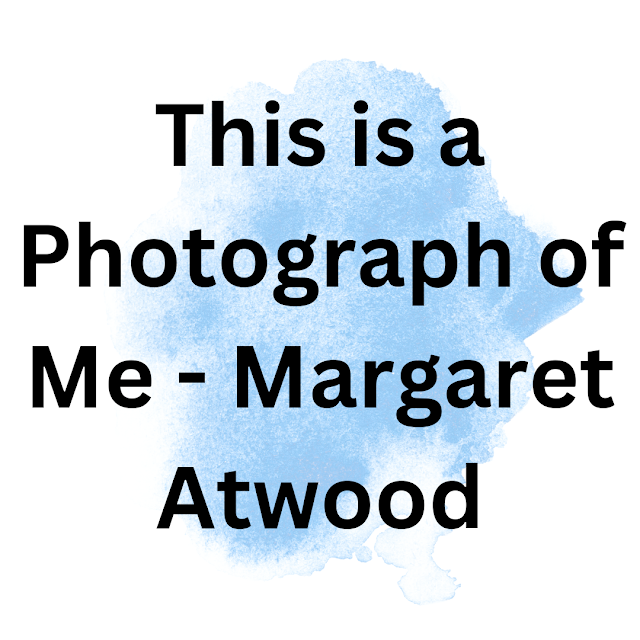This is a Photograph of Me - Margaret Atwood
Also read :-
- Refugee Mother and Child - Chinua Achebe
- Woman to Man - Judith Wright
- The Mystic Drum - Gabriel Okara
- I'm Getting Old Now - Robert Kroetsch
About Poet
Margaret (Eleanor) Atwood (b. 1939) is poet, novelist, critic and champion of her sex and her Canadian heritage. The poet's own resourcefulness and self-assurance can be traced back to her early life experience; her family was continually on the move because of her father's work as an entomologist. She moved into Canada's northern sparsely settled bush country about which she wrote in her poems. Atwood ponders over the knowability of man, celebrates the natural world he lives in and condemns his materialism in her verse collections: Double Perspective (1961), The Circle Game (1964), The Animals in that Country (1968). She taught at many Canadian universities. Role reversals and new beginnings are recurrent themes in her novels, all of them centred on women seeking their identity. The Edible Woman (1969), Surfacing (1972), Lady Oracle (1976), Life Before Man (1979) and Bodily Harm (1981) are some of the novels dealing with these themes. Margaret Atwood's importance lies therefore in her work as a contemporary woman poet.
About Poetry
This Is a Photograph of Me' is a moving poem that shocks the reader when it is read for the first time. The shock given by the second-half of the poem, however, wanes as the poem permanently settles down in the memory like a good photograph that cannot be forgotten easily. The first part of the poem is conventionally descriptive, it is emotional, nostalgic and realistic. The first two lines of the second part (15-16) wake up the reader from an emotional slumber and force him or her to think. The intellectual bewilderment reaches no clarification even at the end, leading to a sense of incompleteness and a feeling of abruptness. Further readings pose several questions before him: is something missing in the poem? Does anything follow after the parenthesis? Is the title a part of the poem? If yes, how should one react to the last line? And then the reader goes back to the first part of the poem again and begins to see the speaker's photograph in it. Then eventually an equation dawns in the mind that the picture of the house is the picture of the person. The person belonged to the house and therefore, even after death, still belongs to it justifying the title, 'This is a Photograph of Me.'
.
This Is a Photograph of Me
It was taken some time ago.At first it seems to bea smearedprint: blurred lines and gray flecksblended with the paper; 5then, as you scanit, you see in the left-hand cornera thing that is like a branch: part of a tree(balsam or spruce) emergingand, to the right, halfway upwhat ought to be a gentleslope, a small frame house. 10In the background there is a lake,and beyond that, some low hills.(The photograph was takenthe day after I drowned. 15I am in the lake,in the center of the picture, just under the surface.It is difficult to say whereprecisely, or to sayhow large or small I am: 20the effect of wateron light is a distortionbut if you look long enough,eventuallyyou will be able to see me.) 25
Glossary
Line 3 smeared spread with marks, stains, oily substance
Line 4. blurred blotted or rendered indistinct
Line 4. flecks spots or speckles
Line 9. balsam or spruce types of fir trees
Explanatory Notes
1. The first part of the poem consists of 14 lines, resembling a sonnet. The second part is of 12 lines. This structure can be modified on second thoughts: the poem has two parts of 12 lines each, and the two lines (13-14) at the centre divide the poem into two parts, functioning as the central support of a seesaw. Thus the poem becomes a vertical seesaw, with the two parts - the house and the speaker hidden in the lake-becoming two pictures. The house of the first part is, thus, reflected in the water of the lake where the speaker drowned, thereby suggesting that the house is the invisible speaker's 'double'. In this way the structure of the poem reveals its theme. Visual communication is basic, the poet makes you see and through seeing gives the meaning The brackets provide, in a way, a substitute for the first part.
2. The poem is artistic because it depends greatly on the reader's response. In a way it is the reader who creates it. If art lies in concealing art, it is the artistic response that really completes art. The poet, however, makes sure that the reader responds positively to the clues given in the poem. How does one respond to the poem then? Let us take a closer look at it.
3. The title of the poem is a part of the poem because the 'it' of the first line refers to the photograph, which is very old, smeared, blurred with lines and flecks. A lot of time has elapsed but the speaker has not forgotten the old house. The sense of belonging for the house has lasted for years. Then comes the exact description of the photograph of the house-the branch of the tree, the slope, the house, the lake and the hills. Then the parenthesis brings the shock. The reader's mind asks whether the word 'after' is wrongly used. But the next five to seven lines clarify that the speaker is at the 'centre' of that picture. So after reading the poem, a reader may complete it with the following lines:
And if you look long enoughYou'll know how I lookedThe day before I drowned.
When the speaker was alive, his/her picture resembled the picture of the house. In this sense, the house becomes 'a photograph of me'.
